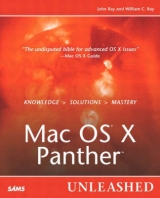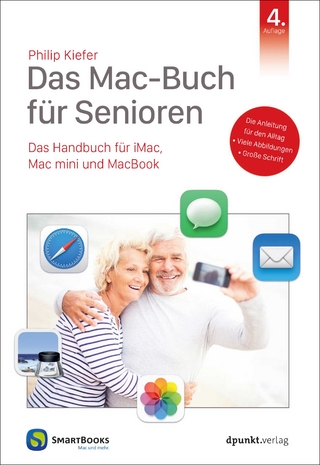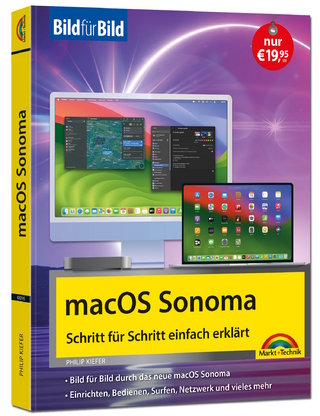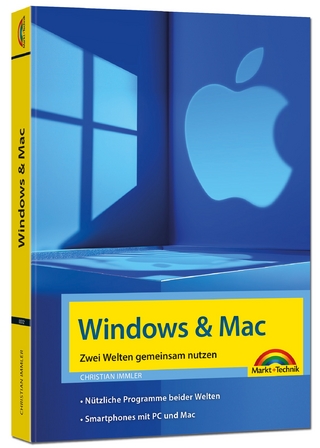
Mac OS X Unleashed
Sams Publishing (Verlag)
978-0-672-32465-9 (ISBN)
- Titel erscheint in neuer Auflage
- Artikel merken
PLEASE PROVIDE
Underneath the new colorful interface of version 10.1 of Mac OS X released Fall of 2001 was a powerful, complicated operating system based on BSD UNIX. Mac users of all kinds needed help both in figuring out how to run OS X and in understanding how OS X worked underneath the covers. In late Summer 2002 Apple is expected to release a new version of OS X—code-named "Jaguar"—adding some end user features (like iChat), that will increase OS X's stability, and will further extend the capabilities of the underlying UNIX-based subsystem. The second edition of Mac OS X Unleashed takes the same approach as the best-selling first edition, helping the reader deal with the most trouble-prone aspects of the user interface—including the new features in the latest version—but focusing to a much greater extent on the BSD environment and how the user or administrator can get the most out of both the current operating system as well as the new components expected in the latest version.
John Ray currently serves as the Director of Engineering/IT Services at Blue Cosmos Design, Inc. An award-winning developer, he provides customized TCP/IP programming solutions to clients nationwide, including The Ohio State University. In the past three years, he has authored or co-authored several books including Special Edition Using TCP/IP, and Maximum Linux Security. William C. Ray is a Unix system administrator, programmer, and trainer. He was responsible for developing a computer-graphics center for The Ohio State University's College of Biological Sciences, where he performed such roles as the center's system administrator, Webmaster, and acting Director. He also has provided user support and Unix training for studentss and faculty members.
(NOTE: Each chapter concludes with a Summary.)
Introduction.
1. Mac OS X Component Architecture.
Darwin. Quartz and Quartz Extreme. OpenGL: Open Graphics Language. QuickTime. Audio. Cocoa. Java 2. Carbon. Classic. Aqua. AppleScript. Migration Issues.
2. Mac OS X Basics.
Welcome to Mac OS X. The File System—Where Did Everything Go? The Apple Menu. Windows. The Application Menu. Menu Extras. The Finder. The Dock. Additional OS Components.
3. The Finder: Working with Files and Applications.
Using the Finder. Finder Status Bar. Finder Toolbar. Finder File Operations. Getting File Information. The Desktop and Finder Preferences. Burning CDs. Using the Dock. Customizing the Dock. Process Manager: Force Quitting Applications.
4. Running Classic Mac OS Applications.
The Classic Environment. Launching Classic. The Boot Process. Running Classic Applications. Maintaining and Monitoring Classic. Direct Booting Mac OS 9.x.
5. Applications and Utilities.
Desk Accessories. Disk Utilities. Graphic Utilities. Other Applications. Help Center.
6. Internet Communications.
Internet Software. Mail. Address Book. iChat. Sherlock. iCal. iSync. Keychain Access.
7. Video, Imaging, and Audio Tools.
Multimedia Software. iMovie. iDVD. Advanced Features. iPhoto. iTunes. Image Capture. QuickTime. DVD Player.
8. Installing Third-Party Applications.
Software Sources and Formats. Using StuffIt Expander. Installing Software. Internet Software. Applications and Utilities. Screensavers. System Additions. Summary.
9. Network Setup.
TCP/IP. The Network Control Pane. AppleTalk. The Sharing Control Pane. Connecting to Remote Servers. Managing Locations. Testing Network Settings.
10. Printer and Font Management.
Print Center. The CUPS System Interface. Printing. Managing Fonts. Font Web Sites.
11. Additional System Components.
User Account Creation. Using NetInfo Manager. Using the NetInfo Database to Customize a User. Enabling the root Account. Groups. System Preferences: Personal. System Preferences: Hardware. System Preferences: System.
12. Introducing the BSD Subsystem.
Unix-Based Mac OS. BSD Philosophy. Using Terminal.app. Interacting with Unix: Basic Unix Commands. The Unix File System. Basic File System Navigation.
13. Common Unix Shell Commands: File Operations.
Rearranging Files. Examining File Contents. Deleting Files. Searching for Files, Directories, and More. File Compression and Archiving.
14. Advanced Shell Concepts and Commands.
Introduction to File Permissions. Process Management. Communication between Processes: Redirection, Pipes.
15. Command-Line Applications and Application Suites.
Networking Applications. Mail Clients. Text Editors. Printing Tools. Bridging the Gap Between the GUI and the Command-Line: Hybrid Software.
16. Command-Line Software Installation.
Installing the Developer Tools. Installing Software at the Command Line.
17. Troubleshooting Software Installs, and Compiling and Debugging Manually.
Common Sense and Configuration Options. File Locations and Fighting with Installers. Using the gdb Debugger. Recommended Command-Line Software Installations.
18. Advanced Unix Shell Use: Configuration and Programming (Shell Scripting).
Customizing Your Shell Environment and Storing Data. Automating Tasks with Shell Scripts. Making Shell Scripts Start at Login or System Startup.
19. X Window System Applications.
Introduction to the X Window System. Installing the XFree86 OS X Distribution. Using Xfree86. Configuring the X Window System. Installing Some Additional Interesting X11 Software. The Commercial Alternative: Tenon XTools.
20. Command-Line Configuration and Administration.
Locating and Editing the OS X Configuration Files. System Services. Strong-Arming the System: Brute Force Behavior Modification.
21. Scripting Languages: AppleScript and Perl.
Introduction to AppleScript. Script Editor. Scripting Syntax. Perl.
22. SQL Databases and Database Connectivity.
MySQL. Creating a Database. Perl/MySQL Integration. iODBC and ODBC Manager.
23. File and Resource Sharing with NFS and NetInfo.
Single-User Mode. Using the NetInfo Database and NFS to Share Resources. Restoring the Local NetInfo Database.
24. User Management and Machine Clustering.
Skeleton User Accounts. Multiple Users and Multiple Machines: Creating Clusters. Cooperating Without Clusters. Command-Line Administration Tools.
25. FTP Serving.
Activating the FTP Server. FTP Server Options. Setting Up Anonymous FTP. Using wu-ftpd as a Replacement for the Default ftpd. Alternatives to FTP.
26. Remote Access and Control.
Security-Minded Thinking. What Is Secure Shell? Activating the SSH Server. Basic Configuration. Basic Use. Advanced Use. Clients. Control Commands.
27. Web Serving.
Apache. Apache Configuration. Rebuilding and Securing Apache. WebDAV-mod_dav. Streaming MP3s—mod_mp.
28. Web Programming.
Introduction to Web Programming. Programming CGIs in Perl. PHP. Alternative Development Environments.
29. Creating a Mail Server.
Running a Mail Server. Activating Sendmail. Sendmail Configuration. University of Washington imapd. Web-Based Email.
30. Accessing and Serving a Windows Network.
SMB and CIFS on Mac OS X. Sharing Files with Samba. Mac OS X SMB/CIFS Client. Sharity. Sharity Application Configuration. Active Directory Integration.
31. Server Security and Advanced Network Configuration.
Why Bother with Network Security. Disabling Access. Intrusion Detection. Where to Go from Here.
32. System Maintenance.
Software Updates. Backups. Diagnostics. Housekeeping.
Appendixes.
Appendix A: Tips and Tweaks—Things You Might Want to Do.
Fix rm So That It Always Runs in Interactive Mode. Turn on Access to the root Account. Add Directories to the System's Path. Tweak Your User Environment So That the Shell Prints Additional Information at the Prompt. Turn Off Coredumps. Automate Updating the locate Database. Hardwire Critical Services. Disable Graphical Login. Limit Access Appropriately.
Appendix B: Installing Mac OS X.
Pre-Installation Considerations and Tips. Evaluating Your Hardware. Preparing Your Drive for Mac OS X. Installing Mac OS X. The Mac OS X Setup Assistant. Wrap-up.
Index.
| Erscheint lt. Verlag | 10.12.2002 |
|---|---|
| Reihe/Serie | Unleashed |
| Verlagsort | Indianapolis |
| Sprache | englisch |
| Themenwelt | Informatik ► Betriebssysteme / Server ► Macintosh / Mac OS X |
| ISBN-10 | 0-672-32465-2 / 0672324652 |
| ISBN-13 | 978-0-672-32465-9 / 9780672324659 |
| Zustand | Neuware |
| Haben Sie eine Frage zum Produkt? |
aus dem Bereich



